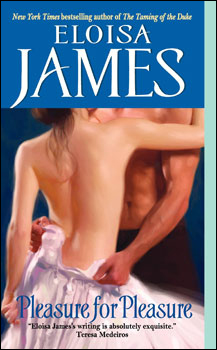
Exclusive Extras
Inside Pleasure for Pleasure
Warning! In describing relations between characters, I may wreck a book for you by making it clear who someone marries, or the outcome of a book. Please do not read about The Inside Take if you're wary of knowing who is paired with whom!
- Josie’s sisters – Tess, Annabel, and Imogen – married in the three books that precede Pleasure for Pleasure. The proper order of the four books is: Much Ado About You, Kiss Me, Annabel, Taming of the Duke and, finally, Pleasure for Pleasure. But they read perfectly well out of order as well.
- Josie quotes the poet Andrew Marvell to Mayne, teasing him by saying that if he had “world enough and time,” he would have seduced most of the women in London. Mayne correctly identifies that poem as Marvell’s “To His Coy Mistress.” The poem is a particularly beautiful seduction-poem written from a man begging his beloved to be less “coy,” or chaste. “If we had world enough and time,” he writes, “this coyness, lady, were no crime.” But since “time’s winged chariot” draws near, he wishes that she would give in to him now, rather than preserving her virginity. Josie also quotes from Shakespeare’s Much Ado About Nothing on page 237; the wonderful Beatrice cries “Oh God, that I were a man; I’d eat his heart in the marketplace!” of her cousin’s traitorous fiancé.
- The seventh earl of Barrymore was actually nicknamed Hellgate, but I assure you that he had no connection whatsoever to the Hellgate that I created for Taming of the Duke. The real earl was a wild youngster, who died at age 24, so he wouldn’t have had time for quite as many affairs as my own Hellgate.
- Sylvie de la Broderie has a most interesting family background, and I thought some of you might like clarification of how she escaped the revolution in France. Basically, her grandfather was beloved by his people, and the villagers actually defended him from mob. So Sylvie’s young father was drawn to Napoleon and Paris, and became Napoleon’s finance minister. But he grew increasingly dismayed by the carnage and corruption of the new regime, and so he wisely began moving his holdings to England. During the Peace of Amiens (1802-1803), he fled safely to England. Sylvie thus moved from Paris to England at age ten.
- Thurman steals all his jokes; I had him steal the idea that a gentleman’s occupation should be smoking tobacco from Oscar Wilde. The withering sarcasm is utterly lost on Thurman, who delivers the line straight.
- I borrowed some of Hellgate’s flamboyant language from love letters written by various persons at that time, including Napoleon himself, and a French actress named Sarah Bernhardt. If you would like to read a collection of luscious love letters, I highly recommend Love Letters: An Anthology of Passion, edited by Michelle Lovric.
- You may have realized that I am very fond of Cinderella make-overs…I put one in my very first book, Potent Pleasures, and sprinkled them throughout other novels as well. For me, the heart of the Cinderella story is a woman coming to terms with the beauty of her particular body, whether it is a very slim one, like Helene’s in Your Wicked Ways, or a curvaceous one, like Josie’s in Pleasure for Pleasure. No matter what kind of body a woman has, the key to self-appreciation (in my opinion) is terrific clothing. Josie is lucky enough to visit Madame Rocque, the same modiste who transformed Helene.
- Given the amount of mail I’ve received on the subject, everyone is worried about Mayne’s age. On page 260 of Kiss Me, Annabel Imogen guesses that Mayne is 37 and he snaps back that he is only 34. In fact, he only just turned 34. Pleasure for Pleasure, he’s about to turn 35.
- Griselda and Darlington talk about an actual murder that took place in 1779, when James Hackman, a respected Anglican minister, shot his former lover Martha Ray – who happened to be the longtime live-in mistress of the Earl of Sandwich, a minister to King George III. There’s a great book on the murder, if you’re interested: Martin Levy’s Love & Madness (William Morrow, 2004).
- Josie’s addiction to books published by the Minerva Press is no creation of mine. In the 1800s, the Minerva Press was busy printing books right along the lines of those I like to read. In 1818, for example, they published Selina Davenport’s four volume novel, An Angel’s Form and a Devil’s Heart. Sounds great to me!






